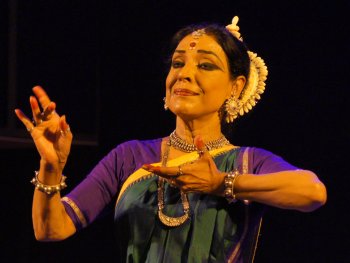 |
|
 |
|
 The dance of another The dance of another- Shveta Arora e-mail: shwetananoop@gmail.com Pics: Anoop Arora January 25, 2014 Parkaya, ‘the body of another,’ was a festival which featured cross currents in classical dance, the expertise of one dancer in her own dance form and the composition chosen by another dancer in her own dance form. The attempt was to expand the boundaries of the performing arts as well as augment existing repertoire meaningfully. Indeed, an endeavor which was neither simple nor easy, but nevertheless featured some interesting experiments. On the first day on January 7th, Odissi dancer Madhavi Mudgal performed. The foyer was bedecked with flower rangolis and intertwining sarees between beautiful posters of the three dancers. Madhavi Mudgal has been trained by Guru Harekrishna Behera and Guru Kelucharan Mohapatra. She is widely acclaimed in India and abroad as a teacher and choreographer. Madhavi said, “I have always admired the structure of Bharatanatyam, particularly varnam. In Odissi, we do not have any such item. In fact, in most dance forms we do not have such a beautiful blend of sahitya and nritta as in a varnam. It has a progression of a definite structure. It was a challenge to retain the essence of varnam and translate it into Odissi. With the thumri, though we do have abhinaya in Odissi as in Geeta Govindam, the challenge was to retain some elements of Kathak.” Madhavi began the performance with an invocation to Lord Nataraja. “My longing for you is the same as that of a peacock at the approach of the rainclouds, as the lotus aspires for the sun, as the ripples merge delicately into the water.” Madhavi depicted the peacock dancing to the clouds, the rays of sun making the lotus bloom. The poem was written by Mayadhar Mansingh and has been set to music by Maheswara Rao. The next piece was conceptualized by Rama Vaidyanathan. It was a varnam, the central piece in the Bharatanatyam repertoire. She chose verses from the Narayaneeyam, a 16th century work by Narayan Bhattathiri, set to music by Madhup Mudgal. The jatis selected by Rama were transcreated in the Odissi nritta technique. The sahitya speaks of the aspirations of the gopis who irresistibly envy Krishna’s flute. They despair, “How fortunate the venu is that it is ever so close to Krishna’s lips. Will we even once have the fortune of tasting a single drop of that nectar? The flute mesmerizes all beings into stillness.” The portrayal by Madhavi showed the adharamrit (the nectar of his lips) that the venu is exclusively entitled to. Krishna, the Gopal or cowherd, takes his cows to Vrindavan and plays the flute. The cows listen to the flute with rapt attention. It is when Krishna plays his flute that Kamadeva strikes his arrow. In nature, birds start romancing and the bees hover over the flowers. The gopis, who are filling their earthen pots with water from the Yamuna, are struck by their desire for Krishna. The subtle blend of excellent nritta and expressive abhinaya by Madhavi held the audience awestruck.  She next presented a thumri which is a signature piece of the Kathak repertoire. The verses were in brajbhasha by two medieval poets, Dev and Chaturbhuj Das. These had been selected and visualized by Prerna Shrimali. This particular piece was my favourite when it came to the magic of music and abhinaya. At a fragrant bower on the banks of Yamuna, when Radha and Krishna arrive in a playful mood, Krishna stops her and doesn’t give her way. Then, in jest, he pretends not to acknowledge her presence. She tries to attract his attention by throwing a flower at him. A very coy Radha tries to cajole Krishna - Shyam sun neare aayo meh. Bheegegi meri surang chunariya, odh pitamber dehu. Damini so darpat hoon pritam nikat apne leho. Das Chaturbhuj Lal girdhar son badheyo adhik sneh. (My chunri is frail against the rain, come and cover me with your dark body. The dark clouds and lightning frighten me, so bring me closer to you). Krishna indulgently draws her closer. Dwelling in the sweet rasa of oneness, they fondly gaze into the same mirror, each the shadow of the other. This is what the second composition describes - Aapas mein ras so rehsen, vihansen Radhika Kunj Bihari, Shyama sarahti Shyam ki pagdi, Shyam sarahat Shyama ki sari. Madhavi portrayed a shy Radha wrapping a sari around her - ekahi aarasi niharat, Shyam kahe neeki tum pyari (both looking at each other in the mirror and praising each other’s beauty). Madhavi translated the piece into Odissi with perfect ease, exhibiting some scintillating abhinaya, portraying the flirtatious chhed-chhaad of the two lovers. The music for the piece was by Pandit Jasraj and Madhup Mudgal. The final piece, a pallavi, is an integral part of Odissi repertoire. Pallavi is a visual representation of musical motifs. It means to elaborate or to flower. The composition was in raag Bhairavi. The nritta showed immaculate technique and movement. The accompanists were Gandhi Mullick and Praful Mangaraj on pakhavaj, with excellent vocals by Purnachandra Majhi and Manikuntala Bhowmik, flute by Rajat Prasanna, tanpura by Devan Singh, sitar by Yaar Mohammed. Lights were by Sharad. Shveta Arora is a blogger based in Delhi. She writes about cultural events in the capital. |